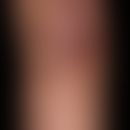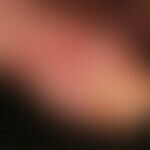Synonym(s)
DefinitionThis section has been translated automatically.
PathogenThis section has been translated automatically.
Mycobacterium marinum (syn. Mycobacterium balnei), organism growing mainly at approx. 26-31 °C in a humid environment. Carriers are infected fish and snails. See also NTM. In up to 80 % of cases it is an aquarium-associated infection. In addition, infection can also occur through direct contact with fish or seafood or in the case of injuries caused by mussels. Transmission from person to person is not known.
You might also be interested in
EtiopathogenesisThis section has been translated automatically.
Inoculation of atypical mycobacteria (e.g. Mycobacterium marinum, see also casuistry; e.g. Mycobacterium aubagnense) after trivial injuries in ornamental fish breeders or, more rarely, during bathing in swimming pools, rivers, dredging holes.
LocalizationThis section has been translated automatically.
Acral (cool) locations are preferentially affected, especially all fingers, the back of the hand (about 90% of cases), more rarely the back of the foot, elbow and knee. The reason for this is the low optimal growth temperature of the pathogens, which at 30-32 °C is significantly below body temperature.
Clinical featuresThis section has been translated automatically.
After an incubation period of 2-3 weeks, development of a red, initially surface-smooth, then hyperkeratotic or crusty, symptomless papule, which develops within 2-3 months into an inflammatory, grey-brown, wart-like, often ulcerated nodule or plate-like elevation.
Size: 1.5 - 2.5 cm in diameter.
The average time to diagnosis was 3.5 months in larger collectives.
Sporotrichoid spread with inflammatory nodule formation in the course of the draining lymphatic vessels or lymph nodes.
Hematogenous dissemination with infestation of testis and epididymis is known.
In immunosuppressed individuals, more extensive soft tissue involvement may occur with spread of infection to subcutaneous tissues, joints, and bones. Systemic involvement is rare.
HistologyThis section has been translated automatically.
Fresh foci show a (relatively uncharacteristic) lymphocyte- and neutrophil-rich mixed-cell inflammatory reaction. In later stages, an acanthotic widened surface epithelium is often encountered with papillomatosis and parakeratotic keratinization. In the dermis, a mostly deep, variably dense, mixed, predominantly mononuclear inflammatory infiltrate with focally interspersed foreign body-type giant cells is seen. In some areas small epithelioid cell nodules are also detectable. Intraepithelially, small aggregations of neutrophil granulocytes can be found.
DiagnosisThis section has been translated automatically.
Clinic, histology (detection of epitheloid-cell granulomas, detection of pathogen genetic material by PCR), cultural pathogen detection with resistance analysis of the culture isolates (detection succeeds on a Löwenstein-Jensen medium at 33 °C).
Differential diagnosisThis section has been translated automatically.
- Clinical:
- Tuberculosis cutis verrucosa (professions:veterinarians, butchers; rare today): usually indistinctly circumscribed, round, oval or polycyclic, indolent or slightly touch-sensitive, brown-red, dermal, verrucous papules or plaques, occasionally papulopustules, erosions with crusting. Lesions are often surrounded by an inflammatory halo. Peripheral progression, central scarring regression. Frequent secondary infection, regional lymph node swelling).
- Sporotrichosis (extremely rare in Europe): usually not very symptomatic, multiple, arranged in chains along the lymphatics (lymphogenic dissemination, similar course to swimming pool granuloma), bluish-red or brown, 0.2-10.0 cm in size, smooth or scaly, sometimes verrucous papules, plaques and nodules with tendency to ulceration or with discharge of purulent secretions (no definite clinical differentiation).
- Syphilis III (history of several years, positive syphilis serology; no sporotrichoid spread of plaques or nodules).
- Leishmaniasis (typical travel history, to be differentiated according to clinical form; histology with pathogen detection).
- Histologic:
- Tuberculosis cutis verrucosa (Clinical information is helpful, usually no sporotrichoid spread; pathogen detection or PCR).
- Leishmaniasis, cutaneous: Analogous histologic picture with acanthosis, pseudoepitheliomatous surface epithelium in places, dense granulomatous infiltrate of neutrophilic granulocytes, epithelioid cell histiocytes and multinucleated giant cells interspersing the entire dermis; in varying density, lymphocytes and plasma cells. V.a. in the Giemsa stain, numerous intracellular pathogens are found in fresh forms. In older foci, the histiocytic component predominates with small isolated or confluent epithelioid cellular nodules).
- Systemic mycoses (e.g., sporotrichosis): Mixed cell inflammatory reaction of the dermis with lymphocytes, granulocytes, histiocytes, and plasma cells. Isolated smaller and larger abscesses. With increasing duration of infection, an increasing granulomatous inflammatory character develops with histiocytes, plasma cells, and giant cells. In HE sections, so-called "asteroid bodies" can be detected in about 30% of cases; detection by Grocott stain).
- Cat scratch disease: Epidermal hyperplasia with ulcerations, mixed cell infiltrate of histiocytes, lymphocytes, plasma cells and epithelpid granulomas. Detection of the causative agent with Warthin-Starry silver stain.
TherapyThis section has been translated automatically.
Internal therapyThis section has been translated automatically.
Initial therapy: combination of clarithromycin (2x 500 mg/day p. o.) and rifampicin (e.g., Rifa 1x 600 mg/day p. o.). This therapy is considered by many authors as the 1st choice therapy. Depending on the extent of the granuloma and the healing process, a therapy duration of several months is usually recommended (four months or more) (Aubry A et al. 2002).
Alternative: For localized foci, doxycycline (200 mg/day p. o.) or clarithromycin (2x 500 mg/day p. o.) are preferred.
Alternative: Combinations of e.g. cotrimoxazole (e.g. Eusaprim forte 2 times/day 1 tbl. p. o.), if necessary in combination with doxycycline (e.g. supracycline) 2 times/day 100 mg p.o..
Alternative: In case of extensive infection or systemic involvement or in case of proven resistance to the above mentioned antibiotics (doxycycline/cotrimoxazole/clarithromycin) combination therapy with rifampicin (e.g. Rifa) 1 time/day 600 mg p.o. and ethambutol (e.g. EMB-Fatol) 15-25 mg/kg bw/day p.o., see also Non-tuberculous mycobacterioses.
Operative therapieThis section has been translated automatically.
Progression/forecastThis section has been translated automatically.
Spontaneous healing in 1-2 years, often with scarring.
ProphylaxisThis section has been translated automatically.
Note(s)This section has been translated automatically.
Pathogen detection: Detection of pathogen genetic material by PCR, cultural pathogen detection with resistance analysis of the culture isolates (detection succeeds on a Löwenstein-Jensen medium at 33 °C).
In principle, therapy should be continued for 4-8 weeks beyond the clinical absence of symptoms.
For further clinical pictures see below Non-tuberculous mycobacterioses
Case report(s)This section has been translated automatically.
Case 1:
In a 60-year-old, otherwise healthy aquarium owner, a gradual, areally growing, completely painless, red plaque formation appeared on the left index finger base joint for several months after formation of an uncharacteristic erythema. After 4 months of unsuccessful local therapy (with steroid externals), 2 additional (sporotrichoid) painless nodules and nodes formed in the course of the regional lymphatics. This clinical course led to a "pragmatic" therapeutic approach with doxycycline 100 mg/day p.o..
The clinical effect was insignificant (due to the duration of therapy), so that a system therapy with 50 mg prednisolone was followed. Under this treatment, an incomplete regression of the nodules occurred. After discontinuation of this treatment (duration 3 weeks) rapid progression and formation of two further nodes on the forearm.
Findings: 5 red-livid, either smooth-surfaced or crusty and scaly (primary nodules covered with a central rhagade and coarse scales), painless, red nodules were found at the base joint of the left index finger and on the forearm, arranged in the course of the regional lymphatic channels. General signs of illness such as fever, exhaustion, lymphadenitis were absent.
Laboratory: o.B.
Histology: In the histological sections no detection of mycobacteria by PCR was possible.
After confirming the diagnosis, a combination therapy of icing with liquid nitrogen 1 time monthly (liquid spray, 40 seconds) and an internal therapy with minocycline 2 times/day 50 mg p.o. for 3 months was performed. Under this complete healing with slight scarring.
Case 2:
A 44-year-old male patient noticed 3 closely grouped, clearly progressive, brownish livid discolored, little painful papules and nodules with a scaly surface on the right forearm since 8 weeks. The rest of the integument was unremarkable. The patient was an aquarium owner and had intensively cleaned his aquarium about 4 weeks ago. In doing so, he had sustained a minor trivial injury to which he paid no particular attention.
Findings: No lymphadenopathy, no pathological laboratory parameters; quantiferon test neg.
Histology: Presentation of epithelioid cell granulomas; no evidence of acid-fast rods.
Culture: Initial findings: evidence of mycobacteria.
Therapy: Under treatment with doxycycline (200mg/p.o./day) only hesitant improvement.
Culture (follow-up findings): Evidence of M. chelonae (resistance to common antibiotics such as: doxycycline, cotrimoxazole, streptomycin and rifampicin). Sensitivity to clarithromycin.
Follow-up therapy: clarithromycin 2x250 mg p.o/day, including gradual healing of nodules after 12 weeks. Treatment was continued for another 6 weeks after clinical healing.
Conclusion: Cause of aquarium granulomas may be fast growing atypical mycobacteria (e.g. M. chelonae) in addition to classical slow growing atypical Mycobacterium marinum. It is important to note that the therapy of fast-growing atypical mycobacteria differs from that of slow-growing mycobacteria due to increasing resistance to commonly used antibiotics (doxycycline, rifampicin).
LiteratureThis section has been translated automatically.
- Altekrüger I et al (1994) Mycobacterioses due to Mycobacterium marinum - contribution to differential diagnosis and based on three case observations. Z Hautkr 69: 175-177
- Di Meo N et al (2015) Sporotrichoid Mycobacterium marinum infection in an elderly woman. Dermatol Online J PubMed PMID: 26295859.
- Fätkenheuer G et al (1995) Clinic and therapy of ubiquitous mycobacterioses. Internist 36: 987-994
- Hallermann C et al. (2011) Therapy-refractory aquarium granuloma caused by fast-growing atypical mycobacteria. Abstract CD 46th DDG Conference: P16/16.
- Haridy M et al (2014) Mycobacterium marinum infection in Japanee forest green tree frogs (Rhacophorus arboreus). J Comp Pathol 151(2-3):277-289Johnson MG et al (2015) Twenty-eight cases of Mycobacterium marinum infection: retrospective case series and literature review. Infection PubMed PMID: 25869820.
- Johnson MG et al (2015) Twenty-eight cases of Mycobacterium marinum infection: retrospective case seriesand literature review. Infection 43:655-662.
- Kirchhoff A et al (1990) Clinic and therapy of dermal infections caused by Mycobacterium marinum. Akt Dermatol 16: 39-41
- Koushk-Jalali B et al (2019) Sporotrichoid fish tank granuloma. QJM. Feb 1;112(2):147. doi: 10.1093/qjmed/hcy203.
- Leuenberger R et al (2000) Clinical presentation and therapy of Mycobacterium marinum infection as seen in 12 cases. Dtsch Med Wochenschr 125: 7-10.
- Lewis FM et al (2003) Fish tank exposure and cutaneous infections due to Mycobacterium marinum: tuberculin skin testing, treatment, and prevention. Clin Infect Dis 37: 390-397
- Macek P et al (2011) Mycobacterium marinum epididymoorchitis: case report and literature review. Urol Int 87:120-124
- Mühlhoff C et al (2008) Aquarium granuloma. Dermatologist 59: 460-463
- Plana-Veret C et al (2014) Invasive Mycobacterium marinum infection. Joint Bone Spine doi: 10.1016/j.jbspin.2014.12.015.
- Seidel A et al (2022) Skin infection by Mycobacterium marinum - diagnostic and therapeutic challenge. An Bras Dermatol 97:366-368.
- Wölfer LU (2009) Atypical mycobacterioses of the skin. Akt Dermatol 35: 295-299.
Incoming links (4)
Fish tank granuloma; Mendelian susceptibility to mycobacterial diseases; Mycobacteria; Mycobacterium marinum;Outgoing links (16)
Cat scratch disease; Cotrimoxazole; Cryosurgery; Curettage; Doxycycline; Ethambutol; Excision; Leishmaniasis (overview); Mycobacterium marinum; Nontuberculous Mycobacteria; ... Show allDisclaimer
Please ask your physician for a reliable diagnosis. This website is only meant as a reference.


















